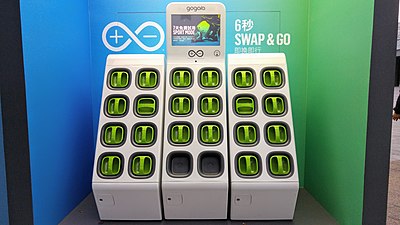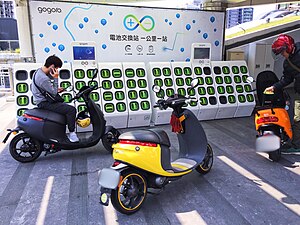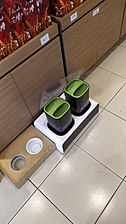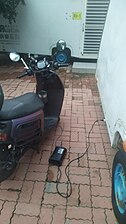
The Gogoro Smartscooter is a series of electric scooters developed by Gogoro and marketed starting in 2015, using an aluminum chassis and a liquid cooled permanent magnet synchronous traction motor. It uses a battery swapping scheme, branded Gogoro Network, to recharge its traction batteries; users pay a monthly subscription fee, the exact value of which depends on their expected usage, to gain access to the company's GoStation public battery dispensing machines. Although at-home charging is possible, starting with the 2 Series scooters released in 2017, owners still are required to pay a monthly subscription fee for Gogoro Network access.
The scooter design integrates sensors that collect information such as speed, energy consumption and levels, system failures, as well as scooter falls. The information is relayed to the Gogoro Energy Network and presented to riders via Gogoro mobile apps compatible with Android and IOS smartphones. The Gogoro mobile app also allows for customization of certain settings such as lighting and sound profiles.
Gogoro Scooter models
The Gogoro Smartscooter has been marketed with multiple models grouped into several different series. The 1 Series was a retronym applied after the 2 Series was introduced in 2017. The 3 Series was aimed at the mid-priced market upon its introduction in 2019, but it was replaced in that market segment by the more affordable Viva Mix, introduced in 2021; the Viva XL uses the 3 Series chassis rather than the Viva Mix. The Viva was Gogoro's lowest-priced Smartscooter when it was introduced in 2019, and Gogoro have since introduced an even more affordable model, the JEGO, in 2024. Between those dates, Gogoro have introduced the CrossOver series, which they bill as a "2-wheeled SUV", and the flagship Pulse, on model-specific chassis.
Series
| Dim.Series | Intro. | Disc. | Length | Width | Height | Wheelbase | Weight (with/ without batteries) |
Trunk volume | Batteries |
|---|---|---|---|---|---|---|---|---|---|
| 1 | Jan 2015 | May 2017 | 1,730 mm (68 in) | 690 mm (27 in) | 1,215 mm (47.8 in) | 1,230 mm (48 in) | 112 / 94 kg (247 / 207 lb) | 24.5 L (0.87 cu ft) | 2 |
| 2 | May 2017 | 1,880 mm (74 in) | 670 mm (26 in) | 1,090 mm (43 in) | 1,306 mm (51.4 in) | 122 / 104 kg (269 / 229 lb) | 25 L (0.88 cu ft) | 2 | |
| 3 | May 2019 | Mar 2022 | 1,845 mm (72.6 in) | 665 mm (26.2 in) | 1,095 mm (43.1 in) | 1,298 mm (51.1 in) | 114 / 96 kg (251 / 212 lb) | 26.5 L (0.94 cu ft) | 2 |
| Viva | Sep 2019 | 1,680 mm (66 in) | 630 mm (25 in) | 1,050 mm (41 in) | 1,164 mm (45.8 in) | 80 / 71 kg (176 / 157 lb) | 21.6 L (0.76 cu ft) | 1 | |
| Viva Mix | Feb 2021 | 1,770 mm (70 in) | 725 mm (28.5 in) | 1,093 mm (43.0 in) | 1,235 mm (48.6 in) | 112 / 94 kg (247 / 207 lb) | 23.9 L (0.84 cu ft) | 2 | |
| CrossOver | Oct 2023 | 1,949 mm (76.7 in) | 673 mm (26.5 in) | 1,132 mm (44.6 in) | 1,374 mm (54.1 in) | 126 / 108 kg (278 / 238 lb) | 18 L (0.64 cu ft) | 2 | |
| Pulse | Jan 2024 | 1,855 mm (73.0 in) | 796 mm (31.3 in) | 1,240 mm (49 in) | 1,332 mm (52.4 in) | 135 / 115 kg (298 / 254 lb) | 21 L (0.74 cu ft) + 2×2.5 L (0.088 cu ft) | 2 | |
| JEGO | Apr 2024 | 1,827 mm (71.9 in) | 685 mm (27.0 in) | 1,230 mm (48 in) | 1,340 mm (53 in) | 97 / 77 kg (214 / 170 lb) | 22.3 L (0.79 cu ft) | 1 or 2 |
1 Series
As initially described in early 2015, the 1 Series traction motor has a maximum power and torque output of 6.4 kW (8.6 hp) at 3250 RPM and 25 N⋅m (18 lbf⋅ft) between 0 and 2250 RPM, respectively. Nominal dimensions are 1,730 mm (68 in) long, 690 mm (27 in) wide, and 1,215 mm (47.8 in) high, riding on a wheelbase of 1,230 mm (48 in). The seat height is fixed at 745 mm (29.3 in) and the scooter weighs 94 kg (207 lb) without batteries and 112 kg (247 lb) with two traction batteries. There is lockable storage of up to 24.5 L (0.87 cu ft) under the seat, alongside the battery slots. While the original 1 Series was available in black or white with silver frame / trim, the 1 Plus added more color options with a darker gray frame color.
The S1 variant is equipped with an uprated motor which boosts output to 7.2 kW (9.7 hp) at 5000 RPM and 27 N⋅m (20 lbf⋅ft) between 0 and 2250 RPM, otherwise sharing the same nominal dimensions and weight. This improves the 0–50 km/h (0–31 mph) acceleration time from 4.2 sec to 3.7 sec. The front brake of the S1 is slightly larger than other 1 Series scooters.
The rear wheel is driven through a planetary reduction gear and Gates carbon belt.
2 Series
Like the preceding 1 Series, the base model of the 2 Series was distinguished from the 2 Plus mainly by the variety of colors available with the latter. 2 Series scooters were longer, wider, and lower than the 1 Series at 1,880 mm × 670 mm × 1,090 mm (74 in × 26 in × 43 in) for the length, width, and height, respectively; the wheelbase was extended to 1,306 mm (51.4 in) and seat height increased to 770 mm (30 in). Nominal weight was also increased to 122 and 104 kg (269 and 229 lb) with and without the two traction batteries, respectively. Underseat storage was increased to 25 L (0.88 cu ft).
The 2 and 2 Plus were equipped with a motor with similar outputs as the 1 Series, with a maximum power of 6.4 kW (8.6 hp) at 3000 RPM and maximum torque of 25 N⋅m (18 lbf⋅ft) between 0 and 2500 RPM.
Traction battery and charging
-
 Gogoro 1 Series with seat open, showing traction batteries
Gogoro 1 Series with seat open, showing traction batteries
-
 GoStation 1.0 (6×4 battery matrix with two open slots)
GoStation 1.0 (6×4 battery matrix with two open slots)
-
 Dual GoStation 3.0 (6×5 battery matrices)
Dual GoStation 3.0 (6×5 battery matrices)
-
 Gogoro scooters at a Super GoStation
Gogoro scooters at a Super GoStation
-
 GoCharger with battery packs
GoCharger with battery packs
-
 GoCharger Mobile
GoCharger Mobile
-
 Smart Battery (V1)
Smart Battery (V1)
-
 Smart Battery (V2)
Smart Battery (V2)
-
 Smart Battery (V3)
Smart Battery (V3)
-
 Smart Batteries (V4) in special colors
Smart Batteries (V4) in special colors
A Gogoro Smartscooter uses one or two removable battery packs (branded Smart Battery) to power its traction motor; the batteries may be removed and charged indoors (using the GoCharger), by plugging the scooter into an outlet (for 2 Series or newer, using the GoCharger Mobile), or depleted batteries may be exchanged for charged ones at battery swapping stations (branded GoStation) belonging to the Gogoro Network.
GoStation
The GoStation was an integral part of the Gogoro Smartscooter launch in 2015; to bring vehicle costs in line with gasoline-powered alternatives, the retail price of the Smartscooter did not include the batteries, which were provided under a monthly subscription plan allowing GoStation access. Each GoStation is a large box with a matrix of slots for individual batteries along with a touchscreen to provide information. After the subscriber removes one or two depleted batteries from the scooter and inserts them into empty slot(s) on the GoStation, an equal number of batteries with an equal or higher charge state will pop out from the GoStation after a few seconds; if the battery that was inserted has a higher charge than all the other batteries in the GoStation, it will be returned.
GoStation 2.0 was introduced in 2018 following the blackout of August 15, 2017; although indistinguishable externally from the original (GoStation 1.0), the 2.0 version is fitted with an internal battery which allows it to operate and dispense batteries without being connected to the grid for 48 hours. The third generation GoStation 3.0 was introduced in September 2019, increasing the number of slots in the same footprint; the internal battery is now able to permit battery swapping without grid power for 64 hours.
Gogoro entered a partnership with Enel X in 2022; under the pilot program, additional hardware was attached to ten GoStations in Taiwan, integrating them into Enel X's virtual power plant, which allowed the connected GoStations to reduce, pause, or reverse power draw in response to overall grid demand. The partnership with Enel X had expanded to cover 1,300 GoStations by April 2023, with plans to connect 2,500 GoStations in total by that June, collectively holding 150 MW-hr.
By October 2023, Gogoro had installed nearly 13,000 GoStations in nine countries; in Taiwan, the collective GoStation storage capacity was approximately 2,000 MW-hr.
GoCharger
The GoCharger is a dual-slot indoor charger which was introduced in January 2016 at CES as part of Gogoro's Owner Proposed Energy Network (OPEN) Initiative. These were offered to businesses without cost if those businesses would allow public access. There are two versions, an overnight charger and a "quick" charger, branded GoCharger or GoCharger Plus, with outputs of 226.35 or 452.7 W per battery, respectively.
GoCharger Mobile, introduced in 2018, allows in-scooter charging using a standard power outlet. A six-hour charge will take an empty battery to 82%. Because the purchase price of the scooter does not include the traction battery, GoCharger Mobile owners still need to subscribe to a battery plan. The GoCharger Mobile connects to a small port under the seat, first fitted to the 2 Series.
History
Design of the battery pack started in 2011; Horace Luke said "Rather than a bigger battery or a cheaper battery, we built a smarter, safer and more powerful battery to meet the energy demands of cities today and the smart cities of tomorrow." Each battery is connected wirelessly to the Gogoro Network. Each swappable traction battery pack weighs 9 kg (20 lb) and uses lithium ion chemistry. Nominal voltage is 48 V. Gogoro holds patents on the battery design, coaxial connector, and vehicle configuration.
The first generation battery pack, released in 2015 alongside the 1 Series, used 18650 cells supplied by Panasonic with a total storage capacity of 1374 W-hr. The third generation battery, announced in April 2019, uses 21700 cells and the capacity has increased by 27% to 1742 W-hr. In 2022, a prototype lithium ceramic solid-state battery pack was shown, developed in partnership with ProLogium. The estimated capacity of the solid state battery pack is 2500 W-hr.
The Industrial Development Bureau, a division of the Taiwan Ministry of Economic Affairs, proposed making the Gogoro battery specification into a nationwide standard in 2018 after Luke announced Gogoro would sell GoStations to other scooter manufacturers and waive licensing fees; however, Kymco flatly stated they refused to use the Gogoro system.
References
- ^ "Gogoro® Smartscooter™ Technical Specifications". Archived from the original on 6 February 2015. Retrieved 4 February 2015.
- Ziegler, Chris (January 5, 2015). "Meet Gogoro, the outrageous electric scooter of the future". theverge.com.
- "Gogoro Recalls 3 Series from Official Site". Energy Trend. March 18, 2022. Retrieved 22 May 2024.
- ^ "Gogoro-S specifications". Gogoro. Archived from the original on November 10, 2016.
- ^ "Gogoro 2 Series specifications". Gogoro. Archived from the original on July 15, 2017.
- ^ "1 Series Specifications" (in Chinese (Taiwan)). Gogoro Inc. Archived from the original on May 31, 2017.
- "New Gogoro 2 Smartscooter Expands Gogoro's Vision for a New Generation of Urban Transportation for All" (Press release). Gogoro Inc. May 24, 2017. Retrieved 22 May 2024.
- "Gogoro Unveils VIVA, a Smaller Lightweight Smartscooter Designed for the Urban Lifestyle" (Press release). Gogoro Inc. October 25, 2019. Retrieved 22 May 2024.
- "Gogoro Introduces VIVA MIX Smartscooter to Meet the Growing Demand for Mass-market Electric Transportation" (Press release). Gogoro Inc. February 22, 2021. Retrieved 22 May 2024.
- "Gogoro Introduces First Two-Wheel SUV" (Press release). Gogoro Inc. October 24, 2023. Retrieved 22 May 2024.
- "Gogoro Unveils New flagship Smartscooter, Pulse" (Press release). Gogoro Inc. January 30, 2024. Retrieved 22 May 2024.
- "Gogoro begins shipping Jego Smartscooter in Taiwan". Taiwan News. April 29, 2024. Retrieved 22 May 2024.
- "Introducing the all new GoCharger Mobile". Gogoro Inc. Retrieved 24 May 2024.
- ^ Chang, Eric (February 12, 2021). "Taiwan's Gogoro Network powered through innovative solutions". Taiwan News. Retrieved 23 May 2024.
- Ziegler, Chris (March 29, 2015). "Gogoro's battery-swapping electric scooter launches this summer in Taipei". The Verge. Retrieved 24 May 2024.
- "GoStation and Smart Battery". Gogoro Inc. Retrieved 23 March 2024.
- ^ "Gogoro Presents 'Energy Grid 2.0' and Introduces GoCharger Mobile as First Step to Expanding Its E-Scooter Business in Eastern Taiwan". EnergyTrend. April 3, 2018. Retrieved 24 May 2024.
- "Gogoro Debuts GoStation 3.0". EnergyTrend. September 27, 2019. Retrieved 24 May 2024.
- ^ Beltran, Rebecca (2023). "Gogoro's battery-swapping stations in Taiwan are now virtual power plants". TechCrunch. Retrieved 24 May 2024.
- Ridden, Paul (April 19, 2023). "Gogoro's battery swap GoStations help with power grid stability". New Atlas. Retrieved 24 May 2024.
- Honan, Mat (October 4, 2023). "2023 Climate Tech Companies to Watch: Gogoro and its scooter and battery pack network". Technology Review. Retrieved 24 May 2024.
- Shu, Catherine (January 5, 2016). "Gogoro's Compact New Electric Scooter Charging Stations Can Be Installed Inside Homes And Stores". TechCrunch. Retrieved 24 May 2024.
- Ziegler, Chris (January 5, 2016). "Thanks to a new charger, Gogoro's cool electric scooter might roll out faster". The Verge. Retrieved 24 May 2024.
- "GoCharger Battery Charger User's Guide". Gogoro Inc. Retrieved 24 May 2024.
- "Gogoro三週年展現不同面貌,Gogoro GoCharger Mobile隨時充電成最大亮點" [For its third anniversary, Gogoro shows a different look; the biggest highlight is Gogoro GoCharger Mobile: charging at any time]. Car Stuff (Taiwan) (in Chinese). March 30, 2018. Retrieved 24 May 2024.
- "The Gogoro Network Smart Battery: All Brain, All Brawn". Gogoro Inc. November 20, 2020. Retrieved 24 May 2024.
- Sokh, Dara; Heng, Sovanchandara (January 2021). Promoting Green Mobility Through Electric Motorcycles in Cambodia (PDF) (Report). Global Green Groth Institute (GGGI). Retrieved 1 July 2024.
- US 10158102B2, Yi-Tsung Wu; Hok-Sum Horace Luke & Chia Nung Wu et al., "Portable electrical energy storage device with thermal runaway mitigation", issued December 18, 2018, assigned to Gogoro Inc
- US 9407024B2, Yi-Tsung Wu; Sung-Ching Lin & Chen-Shin Hsu et al., "Multidirectional electrical connector, plug and system", issued August 2, 2016, assigned to Gogoro Inc
- US 9381826B2, Yi-Tsung Wu, "Battery configuration for an electric vehicle", issued July 5, 2016, assigned to Gogoro Inc
- "Gogoro's new Battery Boasts 170 KM in Cruising Range". EnergyTrend. April 12, 2019. Retrieved 23 May 2024.
- "Gogoro Unveils World's First Swappable Solid State Battery Prototype for Electric Vehicles" (Press release). Gogoro Inc. March 8, 2022. Retrieved 23 May 2024.
- "Proposal to standardize Gogoro's swappable battery tech". Taipei Times. Translated by Edward Jones. February 6, 2018. Retrieved 1 July 2024.
External links
- Gogoro official website
- "Meet Gogoro The Electric Scooter Coming To A Megacity Near You", forbes.com, 5 January 2015
- Greg Kumparak, "After Raising $150 Million In Stealth Mode, What The Heck Is Gogoro?", techcrunch.com, 5 January 2015
- Karissa Bell, "The scooter that could be the future of electric vehicles", mashable.com, 5 January 2015
- Taylor Lorenz, "Mysterious Startup Gogoro Quietly Raises $150 Million For An Electric Scooter You'll Never Have To Plug In", businessinsider.com, 5 January 2015
- Thomas Tamblyn, "This Is An Electric Scooter You’ll Never Need To Charge", Huffingtonpost UK, 5 January 2015
- Katie Fehrenbacher, "Introducing Gogoro, a startup with a consumer energy product for megacities and $100M in funding", gigaom.com, 30 October 2014
- Don Reisinger, "Gogoro preps for CES as it wraps up $100M funding round", cnet.com, 30 October 2014


